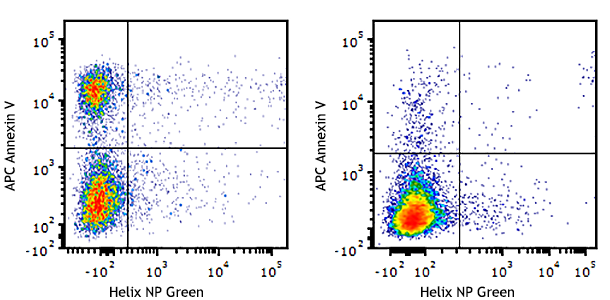- Regulatory Status
- RUO
- Other Names
- PI
- Ave. Rating
- Submit a Review
- Product Citations
- publications
| Cat # | Size | Price | Quantity Check Availability | Save | ||
|---|---|---|---|---|---|---|
| 421301 | 2 mL | 44€ | ||||
Propidium iodide (PI) is a fluorescent dye that binds to DNA. When excited by 488nm laser light, it can be detected with in the PE/Texas Red® channel with a bandpass filter 610/10. It is commonly used in evaluation of cell viability or DNA content in cell cycle analysis by flow cytometry.
Product DetailsProduct Details
- Formulation
- Phosphate-buffered saline, pH 7.2, containing 0.09% sodium azide.
- Concentration
- 0.5 mg/ml
- Storage & Handling
- The solution should be stored undiluted between 2°C and 8°C, and protect from light. Caution: This solution contains hazardous material; handle with care.
- Application
-
FC - Quality tested
- Recommended Usage
-
The suggested use of this solution for viability staining is 10 µl per million cells in 0.5 ml/test, and incubate for 15 minutes at 4 °C before analysis. For Cell Cycle analysis, please see our Propidium Iodide Cell Cycle Staining Protocol. Caution: This solution is toxigenic and mutagenic; handle with care.
- Excitation Laser
-
Blue Laser (488 nm)
- Application Notes
-
Propidium Iodide Solution can be used in evaluation of apoptosis, cell viability and cell cycle analysis by flow cytometry.
-
Application References
(PubMed link indicates BioLegend citation) -
- Vermes I, et al.1995. J. Immunol. Methods 184:39.
- Darzynkiewicz Z, et al. 1992. Cytometry 13(8):795.
- Douglas RS, et al. 1995. J. Immunol. Methods 188:219.
- Sakimoto I, et al. 2006. Cancer Research 66:2287.PubMed
- Liu H, et al. 2012. Int J Biochem Cell Biol. 45:408. PubMed
- Juel HB, et al. 2013. PLoS One. 8:64619. PubMed
- Ren Q, et al. 2013. PLoS One. 8:74732. PubMed
- Zhao W, et al. 2013. Clin Immunol. 149:119. PubMed
- Beggs KM, et al. 2014. Toxicol Sci. 137:91. PubMed
- Ewald SE, et al. 2014. Infect Immun. 82:460. PubMed
- Tsou WI, et al. 2014. J Biol Chem. 289:25750. PubMed
- Kong S, et al. 2014. J Immunol. 193:5515. PubMed
- Product Citations
-
Antigen Details
- Biology Area
- Cell Biology, Cell Cycle/DNA Replication, Neuroscience
- Gene ID
- NA
Related Pages & Pathways
Pages
Related FAQs
- Why is washing not recommended after the addition 7-AAD or PI addition when assessing viability?
-
These dyes bind in equilibrium with DNA. Therefore, external dye concentration must be maintained during analysis and the dye should not be washed out.
 Login / Register
Login / Register 
















Follow Us